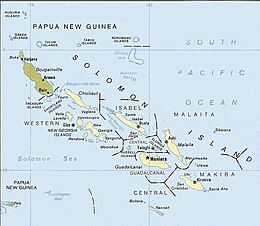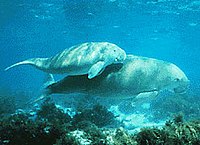Solomon Archipelago
 Aerial view of islands in Solomon Archipelago | |
 The Solomon Islands archipelago | |
| Geography | |
|---|---|
| Location | Pacific Ocean |
| Coordinates | 9°28′S 159°49′E / 9.467°S 159.817°E |
| Archipelago | Solomon Islands archipelago |
| Total islands | 6 main islands and more than 986 smaller islands |
| Major islands | Bougainville, Choiseul, the New Georgia Islands, Santa Isabel, Malaita, Makira (San Cristobal), Guadalcanal. |
| Administration | |
The Solomon Archipelago is a terrestrial ecoregion and marine ecoregion in the Pacific Ocean. It includes the tropical ocean waters surrounding most of the Solomon Islands archipelago (excluding the Santa Cruz Islands, which is a part of the Vanuatu marine ecoregion with the forests being part of the Vanuatu rain forests ecoregion), and includes Bougainville Island and Buka Island of Papua New Guinea and their surrounding waters.
Bougainville is the largest island in the archipelago, while it is geographically part of the Solomon Archipelago, it is politically an autonomous region of Papua New Guinea.
The Solomon Islands rain forests form part of the East Melanesian Islands ecoregion, also known as the Solomons-Vanuatu-Bismarck moist forests, which is a biogeographic region in the Melanesia subregion of Oceania.[1]
Key Biodiversity Areas
[edit]In the Solomon Islands there are 28 land based and 24 marine protected areas formally recognised (PIPAP 2016).[2] The Pacific Islands Protected Areas Portal (PIPAP 2021) states that 530.42 km2 (204.80 sq mi) out of 29,191.65 km2 (11,270.96 sq mi) (1.82%) of the total land area of Solomon Islands is protected, while 1,879.38 km2 (725.63 sq mi) out of 1,609,756.55 km2 (621,530.48 sq mi) (0.12%) of the total marine area is protected.[3]
The protected areas in the Solomon Archipelago include: Arnavon Community Marine Conservation Area, Kolombangara Forest Reserve, Makira Highlands Conservation Area and Komarindi Catchment Conservation Area on Guadalcanal.[4] There are 36 Key Biodiversity Areas identified for the Solomon archipelago, including Kunua Plains and Mount Balbi on Bougainville Island, Mount Maetambe – Kolombangara River Important Bird Area on Choiseul Island, Kolombangara Upland Forest, Guadalcanal Watersheds, Nendö Island and Marovo Kavachi, a submarine volcano known as Kavachi, which is 28 km (20 mi) to the south of Vangunu.[4][5]
Tropical forests of the Solomon Archipelago
[edit]
This ecoregion consists of tropical lowland and montane forests on oceanic islands. The islands are predominantly hill forest, although only a few of the islands are higher than 1,000 metres (3,281 ft) in elevation. The vegetation types in this ecoregion, include mangrove forests and saline swamp forests, coastal strand vegetation, freshwater swamp, riverine forests, different types of lowland rain forests and montane rain forest.[6][2] The Solomon Islanders use trees from different forest types for housing, food and medicinal purposes.[7] Large areas of the natural forest below 400 metres (1,312 ft) have been logged or are planned to be logged. Forest clearing for subsistence agriculture also reduces the amount of natural forest.[5]
Seasonally dry forest and grassland is found only on the leeward (north) side of Guadalcanal as the result of the “rain shadow” caused by the mountains of Guadalcanal which are higher than 2,000 metres (6,562 ft) in elevation.[6]
Coral Triangle
[edit]
Fringing reefs are located around the coast of the mountainous high islands of the Solomon Archipelago including: Choiseul, the Shortland Islands, the New Georgia Islands, Santa Isabel, the Russell Islands, the Florida Islands, Tulagi, Malaita, Maramasike, Ulawa, Owaraha (Santa Ana), Makira (San Cristobal), and the main island of Guadalcanal.
According to the WWF/Nature Conservancy system, the Solomon Archipelago is part of the Eastern Coral Triangle marine province of the Central Indo-Pacific marine realm.[8]
The Solomon archipelago has a rich and diverse marine life, including coral reefs and seagrass meadows. The archipelago is part of the Coral Triangle, the region of the western Pacific with world's greatest diversity of corals and coral reef species. The baseline survey of marine biodiversity in 2004,[9] identified 494 coral species, including nine potentially new species and extended the known range of 122 coral species to include the Solomons.[10] The 2004 survey also recorded 1,019 species of reef fish, of which 47 were species range extensions.[11]
Dugongs are found in the seagrass meadows and near-shore waters.[12]
Reptiles
[edit]
Lizards are the most diverse group of reptiles in the Solomon Archipelago, and within the lizards there are several different types: skinks (including the Solomon Islands skink or prehensile tailed skink Corucia zebrata and Poncelet’s crocodile skink Tribolonotus ponceleti, which are endemic to the Solomon archipelago), geckos, varanids (or ‘monitors’), and agamids (or ‘dragons’) of the genus Hydrosaurus.[6]
Different snake species are found in the Solomon Archipelago, ranging from those that live in the ocean (sea kraits and sea snakes), those that live in moist conditions underground or in rotting logs and leaf litter (blind snakes Acutotyphlops), and those that are found in the trees (South Pacific tree boa, the brown tree snake Boiga irregularis and the Solomons tree snake Dendrelaphis calligastra). The sea kraits, and two other terrestrial species, the Solomons Red Krait Salomonelaps par and the Solomons Black-banded krait Loveridgelaps elapoides, are members of the cobra family (Elapidae) and are considered dangerous due to their toxic venom.[6]
One species of crocodile, the saltwater crocodile (Crocodylus porosus) is found in mangrove swamps, rivers and tidal estuaries, and also in the open ocean.[6]
The mammalian species of the Solomon archipelago
[edit]
Although this oceanic island ecoregion contains only forty-seven mammal species, twenty-six of those species are endemic or near endemic, including nine murid rodents (Melomys, Solomys, Uromys), fifteen pteropodid bats (Dobsonia, Melonycteris, Nyctimene, Pteralopex, Pteropus), one molossid bat (Chaerephon) and the Flower-faced bat (Anthops ornatus). Three of the fruit bats, Bougainville monkey-faced bat (Pteralopex anceps), Guadalcanal monkey-faced bat (Pteralopex atrata) and Montane monkey-faced bat (Pteralopex pulchra), are critically endangered, and three of the rodents are endangered, Buka Island mosaic-tailed rat or Buka Island melomys (Melomys spechti), Poncelet's giant rat or Poncelet's naked-tailed rat (Solomys ponceleti), and emperor rat (Uromys imperator) that is endemic to Guadalcanal.[5]
The bird species of the Solomon archipelago
[edit]
This oceanic island ecoregion has least seven endemic genera of birds. Makira (San Cristobal) and the New Georgia group, have their own endemic species.[5] A total of 199 bird species inhabit the Solomons and of those birds, about 69 bird species are found nowhere else in the world. Two bird species are critically endangered: Makira woodhen (Gallinula silvestris), yellow-legged pigeon (Columba pallidiceps). Four bird species are endangered: imitator goshawk or imitator sparrowhawk (Accipiter imitator), Woodford's rail (Hypotaenidia woodfordi), red-knobbed imperial pigeon (Ducula rubricera), and white-eyed starling (Aplonis brunneicapillus).[5]
References
[edit]- ^ Dinerstein, Eric; et al. (2017). "An Ecoregion-Based Approach to Protecting Half the Terrestrial Realm". BioScience. 67 (6): 534–545. doi:10.1093/biosci/bix014. ISSN 0006-3568. PMC 5451287. PMID 28608869.
- ^ a b Beth Toki, Lyn Leger, Suanne Richards, Sophie Hipkin, Joseph Lorimer, Rod Coulton (2018). Solomon Islands Ecosystem and Socio-Economic Resilience Analysis and Mapping (ESRAM), Volume 1: Introduction and national assessment (PDF) (Report). Apia, Samoa: Secretariat of the Pacific Regional Environment Programme (SPREP). Retrieved 31 March 2021.
{{cite report}}: CS1 maint: multiple names: authors list (link) - ^ "Solomon Islands Protection Coverage". Secretariat of the Pacific Regional Environment Programme (SPREP). 2021. Retrieved 17 April 2021.
- ^ a b Ceccarelli DM, Wini-Simeon, Sullivan, Wendt, Vave-Karamui, Masu, Nicolay-Grosse Hokamp, Davey, Fernandes (2018). Biophysically Special, Unique Marine Areas of the Solomon Islands (PDF) (Report). MACBIO, (GIZ, IUCN, SPREP), Suva. ISBN 978-0-9975451-6-6. Retrieved 31 March 2021.
{{cite report}}: CS1 maint: multiple names: authors list (link) - ^ a b c d e "Solomon Islands, east of New Guinea". World Wildlife Fund. 2020. Retrieved 17 April 2021.
- ^ a b c d e Lavery TH, Pikacha PG, Fisher DO. (2013). Solomon Islands forest life: information on biology and management of forest resources (Report). The University of Queensland, Brisbane. ISBN 978-1-74272-157-6. Retrieved 31 March 2021.
{{cite report}}: CS1 maint: multiple names: authors list (link) - ^ Takuro Furusawa, Myknee Qusa Sirikolo, Masatoshi Sasaoka, and Ryutaro Ohtsuka (2014). "Interaction between forest biodiversity and people's use of forest resources in Roviana, Solomon Islands: implications for biocultural conservation under socioeconomic changes". Journal of Ethnobiology and Ethnomedicine. 10: 10. doi:10.1186/1746-4269-10-10. PMC 3974228. PMID 24468329.
{{cite journal}}: CS1 maint: multiple names: authors list (link) - ^ Spalding, Mark D., Helen E. Fox, Gerald R. Allen, Nick Davidson et al. "Marine Ecoregions of the World: A Bioregionalization of Coastal and Shelf Areas". Bioscience Vol. 57 No. 7, July/August 2007, pp. 573-583.
- ^ Turak, E. edited by Green, A., P. Lokani, W. Atu, P. Ramohia, P. Thomas and J. Almany (2006). Solomon Islands Marine Assessment: Technical report of survey conducted May 13 to June 17, 2004. TNC Pacific Island Countries Report No. 1/06 (PDF) (Report). DC: World Resources Institute. pp. 64–109. Retrieved 31 March 2021.
{{cite report}}:|author=has generic name (help)CS1 maint: multiple names: authors list (link) - ^ Veron, J. E. N., and E. Turak, edited by Green, A., P. Lokani, W. Atu, P. Ramohia, P. Thomas and J. Almany (2006). Solomon Islands Marine Assessment: Technical report of survey conducted May 13 to June 17, 2004. TNC Pacific Island Countries Report No. 1/06 (Report). DC: World Resources Institute. pp. 35–63.
{{cite report}}:|author=has generic name (help)CS1 maint: multiple names: authors list (link) - ^ Allen, G. R., edited by Green, A., P. Lokani, W. Atu, P. Ramohia, P. Thomas and J. Almany (2006). Solomon Islands Marine Assessment: Technical report of survey conducted May 13 to June 17, 2004. TNC Pacific Island Countries Report No. 1/06 (Report). DC: World Resources Institute. pp. 196–267.
{{cite report}}:|author=has generic name (help)CS1 maint: multiple names: authors list (link) - ^ Green, A., P. Lokani, W. Atu, P. Ramohia, P. Thomas and J. Almany (eds.) 2006. Solomon Islands Marine Assessment: Technical report of survey conducted May 13 to June 17, 2004. TNC Pacific Island Countries Report No. 1/06.
